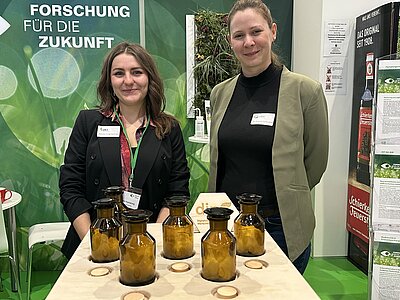Around 300,000 guests visited this year's Berlin International Green Week, which took place from January 17-26. Arianne Schnabel was one of the 1,400 exhibitors who presented their products, projects and ideas at this, Germany's largest trade fair for food, agriculture and horticulture. As coordinator of the DiP-NA-WIR project at the IPB, she and her cooperation partner Natalie Vogelgsang from the Julius Kühn Institute presented this joint project at the stand of Anhalt University of Applied Sciences. In addition to a self-built scent organ, with which the guests could guess different smells, there were numerous discussions about the planned cultivation of herbs such as rosemary and sage in Saxony-Anhalt. This is one of the main topics of NA-WIR; the abbreviation stands for "New Medicinal Plants and Active Ingredients from Saxony-Anhalt."
The NA-WIR project focuses on establishing new medicinal plants in Saxony-Anhalt. With the cultivation of rosemary, sage and Chinese bush nettle, drought-resistant species will find their way into our region. The resulting primary plant products - such as spices, tea or essential oils - are to be brought to market maturity. In addition, specific ingredients with various healing effects play an important role. In the project, these substances, which belong to diterpenes, are converted enzymatically into new potential active ingredients. The scientists aim to produce derivatives with improved efficacy from substances such as carnosic acid or oridonin and test their effects against periodontitis and various cancers.
In general, however, the bioactive compounds can also be extracted directly from the plants, often in high concentrations. In order to optimize the harvest time and yield of the cultivated sage and rosemary plants, it is necessary to easily determine their current amount of these pharmaceutical ingredients. This is also being worked on. With the help of spectroscopic measurements in the field and machine learning, the DiP-NA-WIR project aims to develop a technology that will enable these predictions in future. The data collected will be fed into a data management system that is freely accessible to all project partners from science and agriculture.
The newly established value chains will also be subjected to a sustainability and market transfer analysis to strengthen Saxony-Anhalt's agriculture in the long term.
DiP consortium aims to upgrade coal successor region
DiP-NA-WIR is one of a total of 19 joint projects in the DiP consortium - the BMBF-funded initiative "Model region of the bioeconomy for the digitalization of plant value chains in the Central German coalfield in Saxony-Anhalt". The overarching goal of the DiP consortium is to create a model region for a digitalized, climate-neutral and competitive bioeconomy in the coal succession region in southern Saxony-Anhalt. In the DiP joint projects, more than 40 partner institutions from regional companies, universities and non-university research institutions are working together to achieve this goal. The IPB is represented in seven projects in the DiP consortium, five of which are coordinated by our scientists. In addition to DiP-NA-WIR, these are the projects:
- DiP-BioCasNavi, coordinated by Mehdi Davari, IPB
BioCasNavi is developing an AI-based platform for the automated design of multi-enzymatic cascade systems for the sustainable synthesis of high-quality, industrially usable compounds from renewable raw materials.
- DiP-DiPlanD, the IPB is a partner
DiPlanD bundles regional expertise in the fields of plant breeding, bioprocess engineering, digital measurement and control technology and active ingredient analysis in order to establish Nierembergia repens, as a new agricultural plant in the model region of southern Saxony-Anhalt and to use it as a source of plant-based vitamin D3 and cholesterol for the pharmaceutical and cosmetics industries.
- DiPHyperSpace, coordinated by Katrin Franke & Ludger Wessjohann, IPB
HyperSpace develops the bioeconomic potential of the medicinal plant Hypericum perforatum L. (St. John's wort) at various levels. This includes the identification of new genotypes, genes, enzymes, active ingredients and functions, which can be used for the industrial production of higher-value St. John's wort extracts as well as special ingredients.
- DiP-LeFOS, the IPB is a partner
LeFOS is developing fermentation conditions that enable the production of the sugar compound levan from the waste products of sugar extraction from sugar beet. Enzymes are also being developed that allow the best possible cleavage of the levans into fructooligosaccharides. These oligomeric fructans can be used in a variety of ways, e.g. as hydrocolloids, fat or sugar substitutes.
- DiP-PhosFect, coordinated by Martin Dippe, IPB
In the "PhosFect" project, waste materials from vegetable oil and biodiesel production are to be upgraded into high-quality medical products that play a role in vaccine development in particular.
- DiP-Tres2Cera, coordinated by Bernhard Westermann, IPB
DiP-Tres2Cera is developing processes for the provision of ceramides from pomace, which is produced locally as a waste material during apple pressing. Ceramides have a high economic value. They are used, for example, as starting materials for the production of vaccine boosters.
The Green Week will celebrate its centenary in 2026. In addition to the general product presentation, this trade fair will also next year provide a stage for current topics in society such as climate protection, the circular economy, resource conservation and sustainable land use. The DiP consortium's projects all fit perfectly into this framework.


